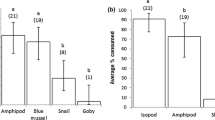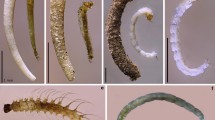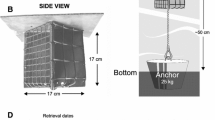Abstract
On the Tona coast, Miyagi prefecture, northern Japan, interactions between the alien predator Laguncula pulchella and its bivalve prey were explored using annually collected quadrat samples over a 10 year period, from 2001 to 2010. A single L. pulchella individual was first recorded in 2002, and the density increased 12-fold from 2002 to 2004. In contrast, population densities of Ruditapes philippinarum and Macoma incongrua rapidly decreased during this interval. Based on frequency of predatory drill holes on the dead shells, more than 35 % of Ruditapes philippinarum and 20 % of Macoma incongrua died because of naticid predation after 2004, while Pillucina pisidium was less vulnerable to naticid predation. L. pulchella focused attacks on P. pisidium in 2004, when R. philippinarum and M. incongrua had became scarce due to naticid predation. This species-selective predation affected bivalve community structure, and caused disagreements in taxonomic composition and species’ rank-order abundance between the living bivalve community and the assemblage of dead shells. This approach (live–dead analysis), frequently used in paleoecological research, is a conservative tool to identify impacts of an alien predator on community structure. When sample size is sufficient, frequency of predatory drill holes in preferred prey species is likely to reflect predation intensity.







Similar content being viewed by others
References
Ansell AD, Morton B (1987) Alternative predation tactics of a tropical naticid gastropod. J Exp Mar Biol Ecol 111:109–119
Beal BF (2006) Relative importance of predation and intraspecific competition in regulating growth and survival of juveniles of the soft-shell clam, Mya arenaria L., at several spatial scales. J Exp Mar Biol Ecol 336:1–17
Buhle ER, Ruesink JL (2009) Impacts of invasive oyster drills on Olypia oyster (Ostrea lurida Carpenter 1864) recovery in Willapa Bay, Washington, United States. J Shellfish Res 28:87–96
Carriker MR (1981) Shell penetration and feeding by naticacean and muricacean predatory gastropods: a synthesis. Malacologia 20:403–422
Carroll M, Kowalewski M, Simões GM, Goodfriend AG (2003) Quantitative estimates of time-averaging in terebratulid brachiopod shell accumulations from a modern tropical shelf. Paleobiology 29:381–402
Chao A, Chazdon LR, Colwell KR, Shen T-J (2005) A new statistical approach for assessing similarity of species composition with incidence and abundance data. Ecol Lett 8:148–159
Chapman JW, Miller TW, Coan EV (2003) Live seafood species as recipes for invasion. Conserv Biol 17:1386–1395
Chiba T, Sato S (2012) Size-selective predation and drillhole site-selectivity in Euspira fortunei (Gastropoda: Naticidae): implications for ecological and paleoecological studies. J Moll Stud 78:205–212
Chikina MV, Kucheruk NV (2005) Long-term changes in the structure of coastal benthic communities in the northeastern part of the Black Sea: influence of alien species. Oceanology 45(supplement 1):176–182
Commito JA (1982) Effects of Lunatia heros predation on the population dynamics of Mya arenaria and Macoma balthica in Maine, USA. Mar Biol 69:187–193
Connell JH (1970) A predator-prey system in the marine intertidal region. I. Balanus glandula and several predatory species of Thais. Ecol Monogr 40:49–78
Cook N, Bendell-Young L (2010) Determining the ecological role of Euspira lewisii: part I: feeding ecology. J Shellfish Res 29:223–232
Dietl GP, Alexander RR (1997) Predator-prey interactions between the naticids Espira heros Say and Neverita duplicata Say and the Atlantic Surfclam Spisula solidissima Dillwyn from Long Island to Delaware. J Shellfish Res 16:413–422
Erthal F, Kotzian C, Simões MG (2011) Fidelity of molluscan assemblages from the Touro Passo Formation (Pleistocene–Holocene), Southern Brazil: taphonomy as a tool for discovering natural baselines for freshwater communities. Palaios 26:433–446
Faber PM (2000) Grass wars—good intentions gone awry. why would anyone bring an alien cordgrass into S.F. Bay? Calif Coast Ocean 16:14–17
Franz DR (1977) Size and age-specific predation by Lunatia heros (Say, 1822) on the surf clam Spisula solidissima (Dillwyn, 1817) off western Long Island, New York. The Veliger 20:144–150
Grey M, Boulding EG, Brookfield M (2005a) Shape differences among boreholes drilled by three species of naticid gastropods. J Moll Stud 71:253–256
Grey M, Lelievre PG, Boulding EG (2005b) Selection for prey shell thickness by the naticid gastropod Euspira lewisii (Naticidae) on the bivalve Protothaca staminea (Veneridae). The Veliger 48:1–6
Hughes RN (1980) Optimal foraging theory in the marine context. Oceanogr Mar Biol Ann Rev 18:423–481
ICES (2004) Alien species alert: Rapana venosa (veined whelk). Edited by Mann R, Occhipinti A, Harding JM. ICES Coop Res Rep 264:1–14
Ishii R, Sekiguchi H, Nakahara Y, Jinnai Y (2001) Larval recruitment of the Manila clam Ruditapes philippinarum in Ariake Sound, southern Japan. Fish Sci 67:579–591
Japan Oceanographic Data Center (2012) http://www.jodc.go.jp/index_j.html#. Accessed 17 Feb 2012
Kabat AR (1990) Predatory ecology of naticid gastropods with a review of shell boring predation. Malacologia 32:155–193
Katz CH (1985) A nonequilibrium marine predator–prey interaction. Ecology 66:1426–1438
Kidwell SM (2001) Preservation of species abundance in marine death assemblages. Science 294:1091–1094
Kidwell SM (2007) Discordance between living and death assemblages as evidence for anthropogenic ecological change. Proc Natl Acad Sci USA 104:17701–17706
Kidwell SM (2008) Ecological fidelity of open marine molluscan death assemblages: effects of post-mortem transportation, shelf health, and taphonomic inertia. Lethaia 41:199–217
Kidwell SM (2009) Evaluating human modification of shallow marine ecosystems: mismatch in composition of molluscan living and time-averaged death assemblages. Paleontol Soc Spec Pap 15:113–139
Kitchell JA (1986) The evolution of predator–prey behavior: naticid gastropods and their molluscan prey. In: Nitecki MH, Kitchell JA (eds) Evolution of animal behavior: paleontological and field approaches. Oxford University Press, New York, pp 88–110
Kitchell JA, Boggs CH, Kitchell JF, Rice JA (1981) Prey selection by naticid gastropods: experimental test and application to the fossil record. Paleobiology 7:533–552
Kosnik AM, Hua Q, Kaufman SD, Wüst A (2009) Taphonomic bias and time-averaging in tropical molluscan death assemblages: differential shell half-lives in Great Barrier Reef sediment. Paleobiology 35:565–586
Kowalewski M (2002) The fossil record of predation: an overview of analytical methods. Paleontol Soc Spec Pap 8:3–42
Kowalewski M, Goodfriend AG, Flessa WK (1998) High-resolution estimates of temporal mixing within shell beds: the evils and virtues of time-averaging. Paleobiology 24:287–304
Krause AR, Barbour SL, Kowalewski M, Kaufman SD, Romanek SC, Simões GM, Wehmiller FJ (2010) Quantitative comparisons and models of time-averaging in bivalve and brachiopod shell accumulations. Paleobiology 36:428–452
Leighton LR (2002) Inferring predation intensity in the marine fossil record. Paleobiology 28:328–342
Lever J, Kessler A, Van Overbeeke AP, Thijssen R (1961) Quantitative beach research II. The “hole effect”: a second mode of sorting of lamellibranch valves on sandy beaches. Neth J Sea Res 1:339–358
Lockwood R, Chastant LR (2006) Quantifying taphonomic bias of compositional fidelity, species richness, and rank abundance in molluscan death assemblages from the upper Chesapeake Bay. Palaios 21:376–383
Navarrete SA, Menge BA (1996) Keystone predation and interaction strength: interactive effects of predators on their main prey. Ecol Monogr 66:409–429
Naylor RL, Williams SL, Strong DR (2001) Aquaculture—a gateway for exotic species. Science 294:1655–1656
Okoshi K (2004) Alien species introduced with imported clams: the clam-eating moon snail Euspira fortunei and other unintentionally introduced species. Jpn J Benthol 59:74–82 (in Japanese with English abstract)
Okoshi K, Sato-Okoshi W (2011) Euspira fortunei: biology and fisheries science of invasive species. Kouseishakouseikaku Press, Tokyo, pp 1–225 (in Japanese)
Padilla DK, Williams SL (2004) Beyond ballast water: aquarium and ornamental trades as sources of invasive species in aquatic ecosystems. Front Ecol Environ 2:131–138
Quijón PA, Grassle JP, Rosario JM (2007) Naticid snail predation on early post-settlement surfclams (Spisula solidissima) on the inner continental shelf of New Jersey, USA. Mar Biol 150:873–882
Quinn BK, Boudreau MR, Hamilton DJ (2012) Inter- and intraspecific interactions among green crabs (Carcinus maenas) and whelks (Nucella lapillus) foraging on blue mussels (Mytilus edulis). J Exp Mar Biol Ecol 412:117–125
R Development Core Team (2009) R: a language and environment for statistical computing. R Foundation for Statistical Computing, Vienna. ISBN 3-900051-07-0. URL http://www.R-project.org
Ruiz GM, Fofonoff PW, Carlton JT, Wonham MJ, Hines AH (2000) Invasion of coastal marine communities in North America: apparent patterns, processes, and biases. Annu Rev Ecol Syst 31:481–531
Sakai K (2000) Predation of the moon snail Neverita didyma, on the Manila clam Ruditapes philippinarum, at the culture ground in Mangoku-ura Inlet. Bull Miyagi Prefect Fish Res Dev Center 16:109–111 (in Japanese)
Sakai K, Suto A (2006) Improvement of sand bed of Manila-clam Ruditapes philippinarum for prevention of predator moon snail Neverita didyma. Miyagi Prefect Fish Sci 6:83–86 (in Japanese)
Sato S, Chiba T, Hasegawa H (2012) Long-term fluctuation in mollusk populations before and after the appearance of an alien predator Euspira fortunei on the Tona coast, Miyagi Prefecture, northern Japan. Fish Sci 78:589–595
Simões MG, Rodrigues SC, Kowalewski M (2009) Bouchardia rosea, a vanishing brachiopod species of the Brazilian platform: taphonomy, historical ecology and conservation paleobiology. Hist Biol 21:123–137
Tamaki A, Nakaoka A, Maekawa H, Yamada F (2008) Spatial partitioning between species of the phytoplankton-feeding guild on an estuarine intertidal sand flat and its implication on habitat carrying capacity. Estuar Coast Shelf Sci 78:727–738
Tezuka N, Kamimura S, Hamaguchi M, Saito H, Iwano H, Egashira J, Fukuda Y, Tawaratsumida T, Nagamoto A, Nakagawa K (2012) Settlement, mortality and growth of the asari clam (Ruditapes philippinarum) for a collapsed population on the tidal flat in Nakatsu, Japan. J Sea Res 69:23–35
Toba M (2004) The decline of Manila clam stock in Tokyo Bay. Bull Fish Res Agen Supplement 1:13–18
Torigoe K, Inaba A (2011) Revision on the classification of recent Naticidae. Bull Nishinomiya Shell Mus 7:1–133 + 15, 4 pls
Wada K, Nishihira M, Furota T, Nojima S, Yamashita R, Nishikawa T, Goshima S, Suzuki T, Kato M, Shimamura K, Fukuda H (1996) Present status of estuarine locales and benthic invertebrates occurring in estuarine environments in Japan. WWF Jpn Sci Rep 3:1–182 (in Japanese)
Weigle SM, Smith LD, Carlton JT, Pederson J (2005) Assessing the risk of introducing exotic species via the live marine species trade. Conserv Biol 19:213–223
Wiltse WI (1980a) Effects of Polinices duplicates (Gastropoda: Naticidae) on infaunal community structure at Barnstable Harbor, Massachusetts, USA. Mar Biol 56:301–310
Wiltse WI (1980b) Predation by juvenile Polinices duplicates (Say) on Gemma gemma (Totten). J Exp Mar Biol Ecol 42:187–199
Acknowledgments
We thank R. Cowie (associate editor) and two anonymous reviewers for reviews, H. Hasegawa (Hosho high school) for providing valuable data, K. Okoshi (Toho University) for helpful advice, and E.M. Harper (Cambridge University) for critical reading of an early version of the manuscript and valuable suggestions.
Author information
Authors and Affiliations
Corresponding author
Rights and permissions
About this article
Cite this article
Chiba, T., Sato, S. Invasion of Laguncula pulchella (Gastropoda: Naticidae) and predator–prey interactions with bivalves on the Tona coast, Miyagi prefecture, northern Japan. Biol Invasions 15, 587–598 (2013). https://doi.org/10.1007/s10530-012-0310-1
Received:
Accepted:
Published:
Issue Date:
DOI: https://doi.org/10.1007/s10530-012-0310-1




